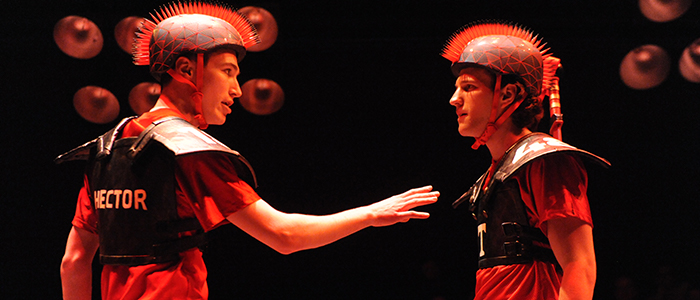Troilus and Cressida: Touchdown for Love?
This blog post is by Chelsey McLaughlin, a senior theatre major.

Troilus and Cressida photo by Stan Barouh
What do the characters of William Shakespeare’s Troilus and Cressida have in common with the youth of 2016? They are powerful, boisterous and relay the news of the latest love triangles via text message. The UMD School of Theatre, Dance, and Performance Studies’ production of Troilus and Cressida provides a modern take on a classic war tale of two rivaling ancient powers in the pursuit of land and love. To those viewers expecting to see the aftermath of a great war in the ruins of Troy, one might be surprised to find the battlefield of mid-13th century BCE adorned with lively infusions of modernity including: track suits with toga-like sashes and traditional ancient battle armor placed atop football jerseys. This adaptation takes inspiration from a high school homecoming football game to tell this story in a reimagined way. Interspersed between tense war scenes, this production also enjoys a soundtrack of many 21st century popular music hits which provide a welcome relief from the strife brought on by the spirited battle scenes.
…one might be surprised to find the battlefield of mid-13th century BCE adorned with lively infusions of modernity including: track suits with toga-like sashes and traditional ancient battle armor placed atop football jerseys.
Classic themes of love, jealousy, ambition, war, and revenge are all elements of this play that make this, as with many of Shakespeare’s works, applicable to the lives of people all over the globe. Although William Shakespeare’s Troilus and Cressida is a play that seldom sees as many revivals as its beloved counterparts Romeo and Juliet, Hamlet and Macbeth, that in no way diminishes its appeal. Tamar Gasko, third-year theatre major and leadership studies minor, plays Priam Leader of Troy and says of the plays updated portrayal that, “Our characters are archetypes of sporty high schoolers, but the reality of the story is indeed the Trojan War.” Gasko insists that the contemporary inspiration for these classic characters puts a refreshing twist on the complex and philosophical work. Of the creative process involved in sculpting her character she adds that, “We used these high school comparisons to create the nuances of our characters, but the real work came directly from the Shakespearean text.”
The use of warm and cool colors in the light plot aids the production in subliminally highlighting while simultaneously reinforcing, the distinct division between the two sides. The contrast provided by the red and blue lighting keeps the audience mindful that the Trojans and the Greeks are two separate entities warring for the victory of their team. This classic story of love, war and loss will engage and envelop you until the final fade to black.
